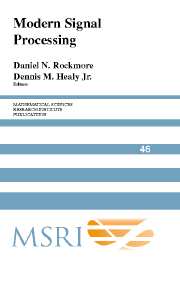Book contents
- Frontmatter
- Contents
- Introduction: A New Generation of Signal Processing
- Hyperbolic Geometry, Nehari's Theorem, Electric Circuits, and Analog Signal Processing
- Engineering Applications of the Motion-Group Fourier Transform
- Fast X-Ray and Beamlet Transforms for Three-Dimensional Data
- Fourier Analysis and Phylogenetic Trees
- Diffuse Tomography as a Source of Challenging Nonlinear Inverse Problems for a General Class of Networks
- An Invitation to Matrix-Valued Spherical Functions: Linearization of Products in the Case of Complex Projective Space P2(ℂ)
- Image Registration for MRI
- Image Compression: The Mathematics of JPEG 2000
- Integrated Sensing and Processing for Statistical Pattern Recognition
- Sampling of Functions and Sections for Compact Groups
- The Cooley-Tukey FFT and Group Theory
- Signal Processing in Optical Fibers
- The Generalized Spike Process, Sparsity, and Statistical Independence
Diffuse Tomography as a Source of Challenging Nonlinear Inverse Problems for a General Class of Networks
Published online by Cambridge University Press: 25 June 2025
- Frontmatter
- Contents
- Introduction: A New Generation of Signal Processing
- Hyperbolic Geometry, Nehari's Theorem, Electric Circuits, and Analog Signal Processing
- Engineering Applications of the Motion-Group Fourier Transform
- Fast X-Ray and Beamlet Transforms for Three-Dimensional Data
- Fourier Analysis and Phylogenetic Trees
- Diffuse Tomography as a Source of Challenging Nonlinear Inverse Problems for a General Class of Networks
- An Invitation to Matrix-Valued Spherical Functions: Linearization of Products in the Case of Complex Projective Space P2(ℂ)
- Image Registration for MRI
- Image Compression: The Mathematics of JPEG 2000
- Integrated Sensing and Processing for Statistical Pattern Recognition
- Sampling of Functions and Sections for Compact Groups
- The Cooley-Tukey FFT and Group Theory
- Signal Processing in Optical Fibers
- The Generalized Spike Process, Sparsity, and Statistical Independence
Summary
Diffuse tomography refers to the use of probes in the infrared part of the energy spectrum to obtain images of highly scattering media. There are important potential medical applications and a host of difficult mathematical issues in connection with this highly nonlinear inverse problem. Taking into account scattering gives a problem with many more unknowns, as well as pieces of data, than in the simpler linearized situation. The aim of this paper is to show that in some very simplified discrete model, reckoning with scattering gives an inversion problem whose solution can be reduced to that of a finite number of linear inversion problems. We see here that at least for the model in question, the proportion of variables that can be solved for is higher in the nonlinear case than in the linear one. We also notice that this gives a highly nontrivial problem in what can be called network tomography.
1. Introduction
Optical, or diffuse, tomography, refers to the use of low energy probes to obtain images of highly scattering media.
The main motivation for this line of work is, at present, the use of an infrared laser to obtain images of diagnostic value. There is a proposal to use this in neonatal clinics to measure oxygen content in the brains of premature babies as well as in the case of repeated mammography. With the discovery of highly specific markers that respond well in the optical or infrared region there are many potential applications of this emerging area; see [AI; A2].
Information
- Type
- Chapter
- Information
- Modern Signal Processing , pp. 137 - 146Publisher: Cambridge University PressPrint publication year: 2004
